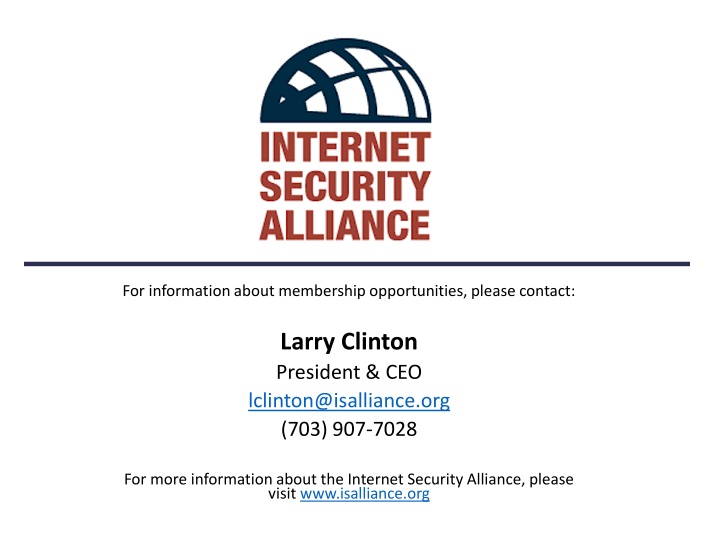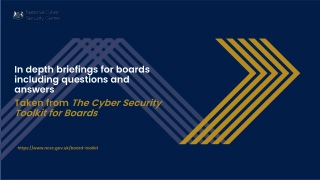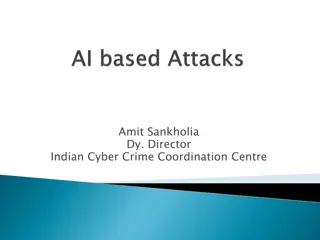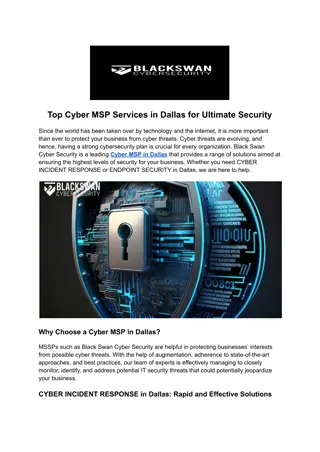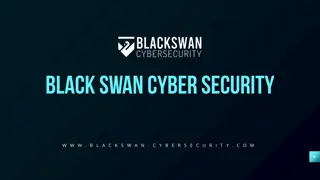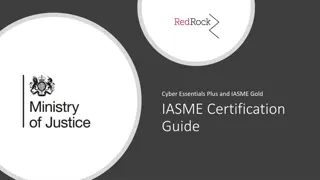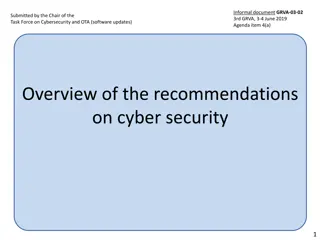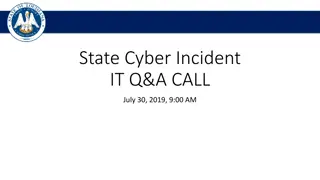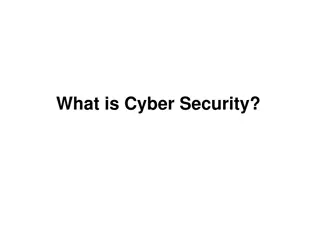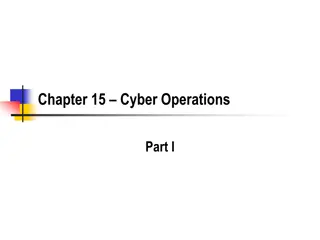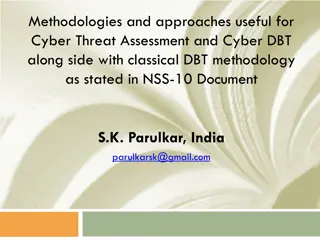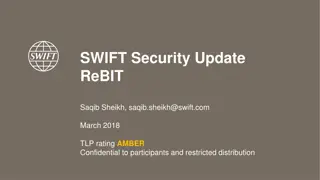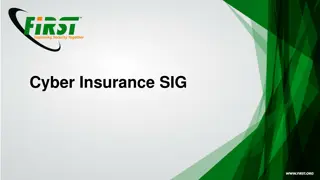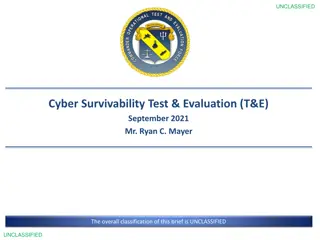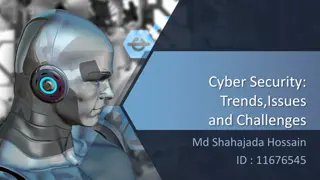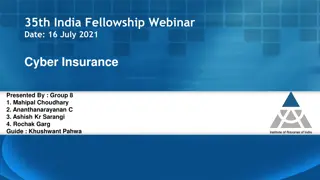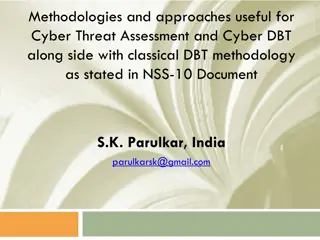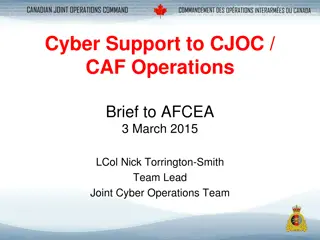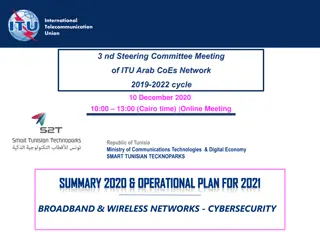Cyber Security Challenges and Recommendations
Military and non-DoD agencies face significant cybersecurity vulnerabilities, requiring urgent action to enhance defenses. The current state of cyber readiness, gaps in security measures, and suggestions for improvement are outlined in this informative content.
Download Presentation

Please find below an Image/Link to download the presentation.
The content on the website is provided AS IS for your information and personal use only. It may not be sold, licensed, or shared on other websites without obtaining consent from the author.If you encounter any issues during the download, it is possible that the publisher has removed the file from their server.
You are allowed to download the files provided on this website for personal or commercial use, subject to the condition that they are used lawfully. All files are the property of their respective owners.
The content on the website is provided AS IS for your information and personal use only. It may not be sold, licensed, or shared on other websites without obtaining consent from the author.
E N D
Presentation Transcript
For information about membership opportunities, please contact: Larry Clinton President & CEO lclinton@isalliance.org (703) 907-7028 For more information about the Internet Security Alliance, please visit www.isalliance.org
How Good are our defenses? The military s computer networks can be compromised by low to middling skilled attacks. Military systems do not have a sufficiently robust security posture to repel sustained attacks. The development of advanced cyber techniques makes it likely that a determined adversary can acquire a foothold in most DOD systems and be in a position to degrade DOD missions when and if they choose. Pentagon Annual Report Jan 2015. 2
Non-DoD Agencies ? Worse Compared to industry sectors fed agencies rank dead last in terms of finding and fixing flaws Comply w/security standards 24% Patch 27% of the time GAO Fed agencies don t use risk management they use the policy method Fed agencies often have right tools but don t have the right people to operate them 3
Things are going to get worse much worse The system is getting even weaker The attackers are getting much better Cyber Economics all favor the bad guys The real crazies could become a real threat 4
Progress on a Path Forward The Cyber Security Social Contract Pan industry White Paper Obama s Cyber Space Policy Review House GOP Task Force Report Obama EO 13636 Info sharing Legislation Trump Cyber EO HHS Industry Cybersecurity Task Force Report Just not doing it fast enough 5
What to do Act with (much) greater urgency Spend (a lot) more money Its not JUST about Critical Infrastructure focus on cyber as a law enforcement issue Organize for the Digital Age Streamline Cyber Regulations Test the NIST Framework Educate Senior Govt. Executives 6
Corporate Boards are getting involved Guidelines from the NACD advise that Boards should view cyber-risks from an enterprise- wide standpoint and understand the potential legal impacts. They should discuss cybersecurity risks and preparedness with management, and consider cyber threats in the context of the organization s overall tolerance for risk. -- PWC 2016 Global Information Security Survey 8
Boards are taking action Boards appear to be listening to this advice. This year we saw a double-digit uptick in Board participation in most aspects of information security. Deepening Board involvement has improved cybersecurity practices in numerous ways. As more Boards participate in cybersecurity budget discussions, we saw a 24% boost in security spending. --- PWC 2016 Global Information Security Survey 9
Actual Cyber Security Improvements Notable outcomes cited by survey respondents include identification of key risks, fostering an organizational culture of security and better alignment of cybersecurity with overall risk management and business goals. Perhaps more than anything, Board participation opened the lines of communication between the cybersecurity function and top executives and directors -- PWC 2016 Global Information Security Survey 10
What to do (cont.) Adopt a risk management approach to cyber security Workforce development focus as much on people as tech and make cyber security cool Define Govt role in nation state attacks Realign the cyber incentives Rethink the compliance model 11
HHS Industry Cybersecurity Task Force Report ISA Policy Positions HHS Cybersecurity Report Recommendations Require federal regulatory Harmonize, Streamline & Rationalize Healthcare Sector Cybersecurity Regulations (ISA Trump EO Memos; ISA Cybersecurity Social Contract) agencies to harmonize existing & future laws and regulations that affect healthcare industry cybersecurity (Rec 1.3) Develop executive education programs targeting executives and Boards of Directors about the importance of cybersecurity education (Rec 4.1) Industry and government should partner to establish prioritized best practices for the healthcare sector (Action Item 1.2.3) Agency Heads Should receive Cyber-Risk Management Training (ISA Trump EO Memos; ISA Cybersecurity Social Contract) Government and industry need to partner together to develop shared goals and priorities (ISA Cybersecurity Social Contract) 12
HHS Industry Cybersecurity Task Force Report (cont.) ISA Policy Positions HHS Cybersecurity Report Recommendations The Report lists a plethora of Incentivize Healthcare to Implement Best Cybersecurity Practices (ISA Trump EO Memos; ISA Cybersecurity Social Contract) incentive options for the healthcare sector, including: A Cash for Clunkers for upgrading IT infrastructure (Action Item 2.1.4) Grants and tax incentives for small businesses who show they are actively improving cybersecurity profiles (Action Items 3.3.1, 3.3.2, 3.4.1, 3.4.2) Establish a conformity assessment model for evaluating cybersecurity hygiene that regulatory agencies and industry could rely on (Rec 4.3) Reform the Cybersecurity Auditing process (ISA Trump EO Memos; ISA Cybersecurity Social Contract) 13
HHS Industry Cybersecurity Task Force Report (cont.) ISA Policy Positions HHS Cybersecurity Report Recommendations Develop the healthcare workforce Workforce Development: focus on recruiting people to help fill the workforce development gap, which goes beyond technical expertise and runs to overall risk management (ISA Trump EO Memos; ISA Cybersecurity Social Contract) capacity necessary to prioritize and ensure cybersecurity awareness and technical capabilities (Imperative 3) Increase healthcare industry readiness through improved cybersecurity awareness and education (Imperative 4) Congress should identify resources for improving research addressing small and rural provider security challenges (Action Item 5.1.4) Industry should develop use cases and contracts tailored for small and medium- sized organizations (Action Item 3.4.4) Government priority for working with the private sector should be reversed to emphasize smaller companies (ISA Cybersecurity Social Contract) 14
HHS Industry Cybersecurity Task Force Report (cont.) ISA Policy Positions HHS Cybersecurity Report Recommendations Tailor information-sharing for easier Government should restructure information-sharing programs to make them more user friendly to smaller firms (ISA Cybersecurity Social Contract) consumption by small and medium- sized organizations who rely on limited or part-time security staff (Rec 6.1) The NIST Cybersecurity Framework needs to be assessed to determine use, effectiveness, and cost effectiveness, so that elements can be properly prioritized (ISA-FAIR Joint Comments on NIST CSF v1.1; ISA Cybersecurity Social Contract) HHS and NIST must develop guidance about how to apply the framework to the healthcare sector (Action1.2.2) 15
